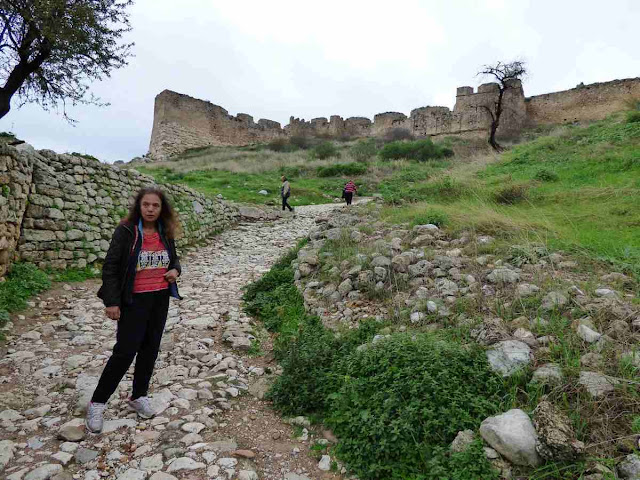Day 9, Part 2:
Ancient Nemea was next.
Ancient Nemea:
Nemea was a religious sanctuary where pan-Hellenic athletic games were held every two years from 573 BCE until 271 BCE, after which, the Games were moved to Argos.
Situated near the foothills of the Arcadian mountains, 333m above sea level in a long narrow valley, the site reached its period of greatest importance from the 6th to 3rd centuries BCE.
Athletic games were held at Olympia, Isthmia and Delphi as well. The Nemean Games were the youngest of the four but the fact that Nemea was held in as equally high regard as Olympia is evidenced in an Athenian law of c. 430 BCE which gave a victor at either event free meals for life.
Story of the origin of the Nemean games is as follows:
Hercules after his first labor in which he had to kill the Nemean lion living in the caves of Mount Tritos above the site, established athletic games in honor of his father Zeus.
There's another story. Lykourgos, the priest-king had a son Opheltes and seeking to protect his son asked the Delphic oracle for advice. The response of the oracle was to prevent the baby from touching the ground until he had learned to walk. Opheltes was put under the care of a slave called Hypsipyle but while engaged fetching water for some passing champions on their way to Thebes (the famous Seven against Thebes) the unattended baby was fatally attacked by a snake while he slept in a bed of wild celery. Taking this as a bad omen, the champions organised a funeral games to propitiate the gods and commemorate the unfortunate Opheltes. Thus the Nemean Games were born.
Athletes competed naked and victors were awarded a crown of wild celery.
Architectural remains at the site are dominated by the impressive Temple of Zeus constructed c. 330 BCE
There is a small museum with some good pieces.
We drove to the stadium
The stadium of Nemea which is visible today, dates from 330-320 BCE and was built between two natural ridges providing an elevated vantage point for spectators and allowing a capacity as high as 30,000 people. A locker-room (apodyterion), once with an open central court, is connected to the stadium track by an arched tunnel measuring over 36 m in length and nearly 2.5 m in height.
The track itself is the usual 600 ancient feet in length (178 m) with small marker posts indicating every 100ft. Still in situ is the stone starting line (balbis) where athletes placed their front foot.
We had some food
We then drove on to Acrocorinth.
Acrocorinth:
Acrocorinth was first a Greek acropolis, then a Roman citadel. Later it became a Byzantine fortress. The Franks captured it in 1210, and it then fell into the hands of one of the rulers of Naples. An arms manufacturer and banker then owned it, followed by the Knights of Rhodes, the Turks, the Venetians, then the Turks again, and finally the Greeks once more.
As we walk up from the car park, we get a good view of the three lines of defense and the three gates which protected the citadel from the west.
First gate: This was built in the 14th C. A moat was cut out of the rock to provide a defense against attack.
Second gate: The Venetians were responsible for building this gate. on one side they built a tower.
Third gate: This gate has two rectangular towers on either side. The one on the right is mostly from the 4th C BC, while the other one is Byzantine. Most of the walls in this area are also Byzantine.
Aphrodite was worshipped here. The temple area was a center of religious prostitution. Some ancient authors claimed that over 1,000 prostitutes worked here, and as a result Acrocorinth was notorious for its licentiousness all over the ancient world. It's been suggested that St Paul may have preached here during his visit to Corinth.
There is a keep, one column from the Aphrodite temple, even a spring created by winged horse Pegasus.
We stopped midway as we were running out of time.
Here I am sitting in the middle of the huge citadel...while son climbed further up
Lovely views when we were driving down from Acrocorinth.
We wanted to reach Athens before dark. We had an early morning flight at 6.55 am. Decided to retain the car and turn it in early morning as we did not want to depend on our hosts for the early airport drop off.

We were looking out for signs to Athens airport as our B&B was near the airport. There was some confusion as sign boards were saying Marcopolo airport and ours is the international airport Eleftherios Venizelos. Lamia was also coming up on the boards. A toll agent said we are OK and asked us to take exit 16. We reached our destination without any issues by 5 pm. Called up our hosts and they were waiting. Amelia promised to bring in the breakfast in the evening and by 7 it was in, pretty good stuff. I had made some veggies and rice too as the food was delayed... no probs, we packed it up for next day
It had been a great day and we slept off happily.
VIDEO LINK:
Our video of Epidaurus amphitheater, museum, Tiryns, Mycenae:
Our video of Ancient Nemea and Akrocorinth is here:
Report on our first day in Spectacular Santorini is here:
https://adventuretrav.blogspot.com/2018/12/greece-trip-report-day-10-santorini.html






































































Excellent report and photos! Like it so much!
ReplyDeleteAppreciate your nice comments, Γιωργος
ReplyDelete